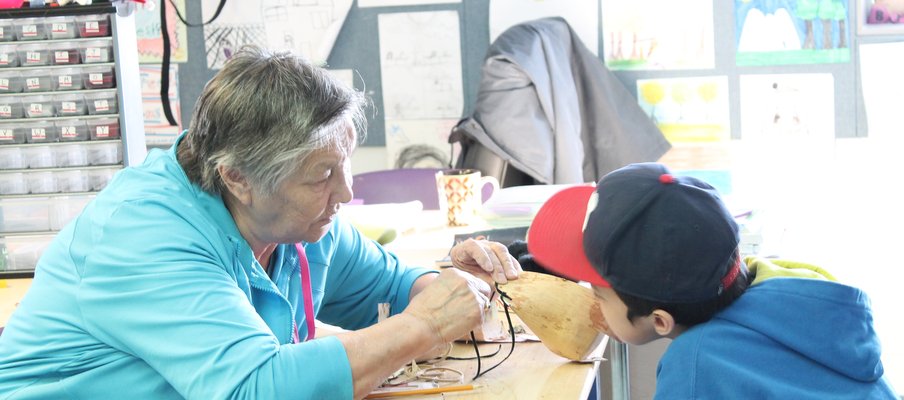Cultural Arts Camp receives rave reviews from elders and students in Turnor Lake

Related Programs

The Cultural Arts Camp, hosted by the Birch Narrows Dene Community School, has started something they can’t stop, and its positive impact will be long lasting for the community of Turnor Lake.
Getting Started
Culture Week is an annual event at the school in Turnor Lake, which is located approximately 500 km north of North Battleford. Planning for the 2014 edition of the event began immediately after the previous year's activities came to an end. Organizers wanted to build upon the week's activities to expose students to different mediums of art, including those of the Dene and Cree cultures, as well as other Aboriginal cultures in Saskatchewan.
Jocelyn Dreaver, one of the organizers of the Cultural Arts Camp, as well as the vice-principal and special education teacher, Birch Narrows Dene Community School, explains "We've held Culture Week for a number of years. Using some of the local elders, we've done beading and activities like that. We wanted to engage the students in different kinds of workshops that would possibly challenge some of them. We wanted to expose them to new art and different kinds of art forms."
Planning progressed through the summer of 2013, with Dreaver turning to a familiar face for assistance - her sister, Audrey Dreaver. Beyond providing trusted advice, Audrey also proved valuable with her own unique point of
view as an artist. "When (Jocelyn) first approached me and was asking me questions, I gave her suggestions on what to do," she says. "Then when they made the commitment to create it, I made the suggestion that instead of calling it an art camp, they call it an artistic culture camp because it's all about the artistic culture. Art is an important part of our lives - it's not outside our lives, it's part of everything we do."
Besides a title for the event, Audrey also steered organizers towards funding for the project. They applied for and received grants from SaskCulture (Aboriginal Arts and Culture Leadership Fund) and the Saskatchewan Arts Board (Indigenous Pathways Initiatives Grant), which ultimately allowed them to stage the camp.
“Nuhe chalani Hedarilden”
At the start of the current school year, the Culture Committee was formed to involve the school's teachers and continue planning for the camp. Then, monthly meetings were held with the local elders to receive their feedback and direction. By then the committee had a name for the project - Learning Our Culture, which translated into Dene is "Nuhe chalani Hedarilden."
From March 17-20, students from Kindergarten to Grade 12 at Birch Narrows Dene Community School were treated to artists from inside and outside their community, representing a variety of mediums, including: painting, carving, air-drying clay, birch bark canoes and baskets, storytelling, Métis jigging, traditional games, drumming, and drum-making. Elders were assigned to each of the activities in order to further the connection between the arts and Aboriginal culture. On the final day of the week they enjoyed a traditional community feast.
Engaging the Community
"They would start every afternoon with an elder telling stories. I was in the painting session and our elder talked about colour in nature, and how colour was drawn from the different plants and the significance of colour," explains Audrey Dreaver.
"(The students) were completely immersed in the stories they were listening to. When they went to do their own paintings, a lot of them ended up creating imagery that was based on some of the stories that they heard from the elder. He totally changed how they were approaching colour right from the start,” she says. “That was a really important element of connecting art to culture. That's what made it an artistic culture camp.”
By its very name, the intersection of arts and culture was the focus of the Learning Our Culture project. Although it would have made the name unwieldy, Jocelyn Dreaver explains that another key component was engagement - engagement of students, engagement of elders and engagement of the entire community. “Several years ago the elders played an active role in the school,” she says, “but over time they gradually drifted away." With attendance an issue among the older grades at Birch Narrows Dene Community School, some of the students in the community also have engagement issues. Although the students were slow to warm to the camp, by the end of the week the students and elders were fully immersed in the festivities. "It exceeded my expectations," she says. "I knew we would have some small problems along the way, but overall the students enjoyed it, the artists enjoyed it and so did the elders.
“(The elders) said to us we started something that we can't stop, which is being with the kids and being in the school."




